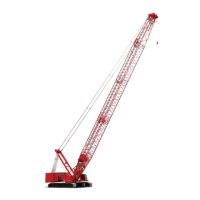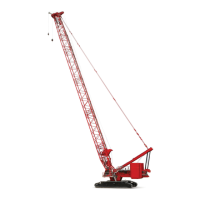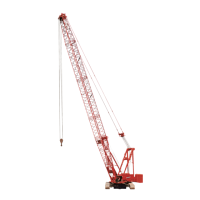OPERATING CONTROLS AND PROCEDURES MLC90A-1/MLC100-1 OPERATOR MANUAL
3-52
Published 12-10-19, Control # 258-05
COLD WEATHER OPERATION
Also see AC Power Supply on page 3-54.
Crane Limitations
The static load-carrying limitations of the steels used in
Manitowoc cranes are not affected by cold weather.
Manitowoc’s capacity charts are acceptable for use in cold
weather.
However, dynamic loads (impact and shock) can affect the
steels used in Manitowoc cranes when operating in cold
weather. Dynamic loads are created by traveling, sudden
application and release of load, and duty-cycle operations.
Wire Rope
Wire rope manufacturers state that wire rope will not become
brittle in temperatures down to -34°C (-30°F). However,
lubrication may be a problem during extremely cold weather
because normal wire rope lubricants may harden and chip
off, leaving rope without lubrication.
Consult your wire rope supplier for recommended cold–
weather lubricants.
Cold Weather Starting Aid
The engine has a heater (“grid heater”) in the air intake that
comes on during crane startup.
To prevent overheating, the oil pan and coolant heaters
must be unplugged when the engine is running or when
the ambient temperature is above –1°C (30°F).
Cooling System
The cooling system must be kept full and be protected from
freezing at the lowest expected ambient temperature. See
engine manual for antifreeze recommendations.
A mixture of 40% antifreeze and 60% water provides freeze
protection to -37°C (-35°F). A mixture of 60% antifreeze and
40% water provides freeze protection to approximately -
51°C (-60°F). 100% antifreeze will freeze at -23°C (-10°F).
Batteries
To provide maximum cranking power and to prevent the
batteries from freezing, they must be kept fully charged
(resting voltage 12.4V–13.2V) and warm when crane is idle
during cold weather.
It is recommended that batteries be stored indoors or heated
with a battery heater when crane is idle. Be aware that:
• A battery with a 50% charge freezes at -27°C (-16°F). A
battery with a 100% charge freezes at -57°C (-70°F).
• A battery with a 100% charge retains only 40% of its
cranking power at -18°C (-0°F). At -29°C (-20°F), the
same battery retains only 18% of its cranking power.
Engine Oil, Gear Oil, and Hydraulic Oil
For extreme cold, refer to Approved Lubricants for Operation
in Arctic Climate in the Lubrication Guide.
DANGER
Injury and Equipment Failure Hazard
At low ambient temperatures, dynamic loads (impact and
shock) can result in structural failure leading to serious
injury or death.
When operating in ambient temperatures of:
–20 to –30°C (–5 to –22°F):
• Avoid impact or shock-loading of the crane and any
attachment.
• Conduct operations with regard to potential failure of
hydraulic components.
–31 to –40°C (–23 to –40°F):
• De-rate crane by 40% for all lift operations. Halting all
lifts should be considered.
• Duty-cycle operation is prohibited.
below –40°C (–40°F):
• All operation (lift and duty-cycle) is prohibited except
in extreme emergencies, and then only with approval
from a competent engineer who has de-rated crane
accordingly.
WARNING
Engine Explosion Hazard
An explosion and serious burns may result if ether is
sprayed into the engine air intake.
Do not spray any combustible starting aid (ether) into the
air intake. The grid heater will ignite the ether.
CAUTION
Avoid Hydraulic Component Damage
Before operating any hydraulic components, always allow
the hydraulic system to warm up to 7°C (45°F).
To activate the crane’s hydraulic oil warm-up circuit during
cold weather startup, all crane functions must be parked.
The warm-up circuit will remain on until the hydraulic oil
temperature reaches 10°C (50°F). If a function is
unparked, the warm-up circuit will deactivate and remain
deactivated until all functions are parked and the
hydraulic oil temperature drops below 8°C (46°F).













